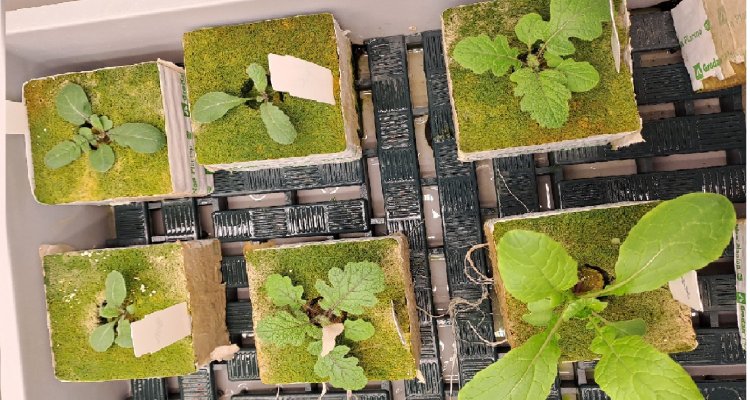
Project
Natural variation in photosynthesis and leaf development under high light in a Brassica panel
Brassicas are a group of species belonging to the Brassicaceae family. In this project, we will study B. rapa (cabbage), B. nigra (mustard), and Hirchfeldia incana. Hirschfeldia incana is proposed as a model species for studying photosynthesis because of its high photosynthesis rate when plants are grown under high light conditions. To assess the real photosynthetic capabilities of H. incana this project, we aimed to compare the C02 assimilation rate and dry biomass during the development of the leaves of the three species.
Project description
Recently Hirschfeldia incana was proposed as a model species for the exploration of high maximum CO2 assimilation rates (Garassino, 2022). Hirschfeldia incana exhibits exceptional C3 photosynthetic characteristics with a maximum photosynthetic capacity of 55 µmol m-2 s-1. H. incana belongs to the Brassica clade in the Brasisseacea family, along with B. rapa (cabbage) and B. nigra (mustard). These three highly related species pass through a whole triplication genome, which explains their large genetic variability. Previous results have shown that H. incana outperformed B. nigra, and B. nigra outperformed B. rapa in terms of photosynthesis when plants were grown under high light conditions. This result
suggests a natural genetic variation in photosynthesis within the Brassica group. However, given the morphological differences between these species, it is difficult to compare photosynthetic measurements at only one time point. This is because photosynthesis depends on the phenological stage of the plant and leaf development. This project focused on answering the following questions: How much change does photosynthesis during leaf development? How does light affect photosynthesis during leaf development? Are the leaves selected previously comparable to each other? Can we estimate the full CO2 assimilation of plant during the vegetative stages?
Objectives and methods
The aim of the project is to understand the interaction between phenology, leaf morphology and photosynthesis in response to light intensity in a range of Brassicaceae species. This will improve our understanding of how high rates of photosynthesis are achieved and how this genetic variation can be utilized.
Required skills
- Knowledge of plant physiology, in particular
photosynthesis - Knowledge of experimental design and statistical analysis
- Experience or affinity with measurements of photosynthesis
- Experience or affinity with programming (in R)
Types of research / work
We offer the interested MSc student the opportunity to participate in an experiment in the context of an ongoing research project on high photosynthesis
The type of research can include:
- Measurement of photosynthesis (light responses curves) with the Licor6800 in plants (B. rapa, B. nigra, H. incana) during leaf development under both usual treatments (250 umol light + 1800 umol light)
- Design and execution of an experiment to monitor the biomass during the vegetative stages of the plants under controlled conditions
- Modeling photosynthesis (using an R package)
- Compare photosynthesis parameters within species in treatments with high light and low light
- Compare photosynthesis parameters among species in each treatment
Period
This project can be started at any time.